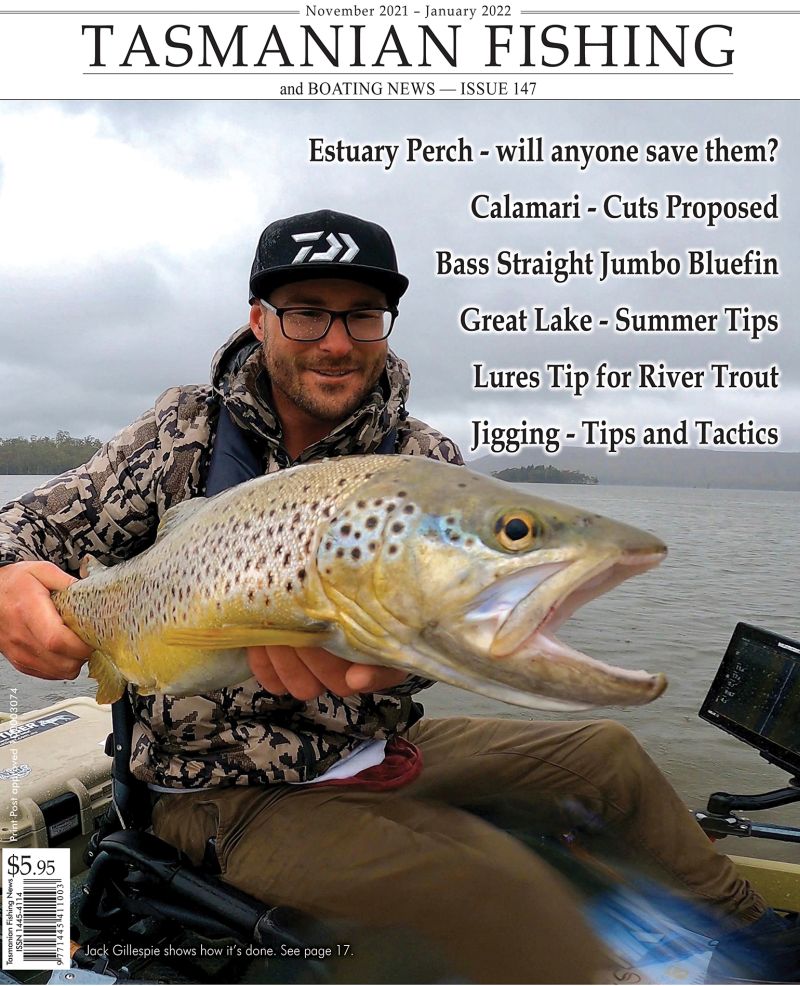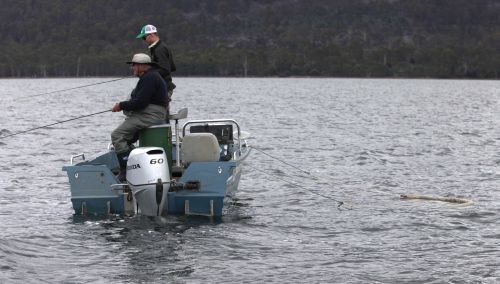From the Archives ...
Atlantic salmon the hard way
Atlantic salmon the hard way
Scott McDonald
The first Atlantic salmon eggs used to begin Tasmania's Atlantic salmon aquaculture industry were introduced into Tasmania in 1984. From these humble beginnings a valuable Tasmanian industry has evolved with a worldwide reputation for having a premium disease free product. This industry provides a spin off to all anglers in the form of regular escapes of salmon from the farms.
Great Lake - Fishing the waves
Shane Flude
As we go to print many of Tassie's rivers are still in flood, most of the major storages are filling nicely and a number of those dams on the Mersey/Forth and Derwent river systems have been spilling for two months. What all this means to the avid trout angler is that we are simply spoilt for choice of locations at the moment. Great Lake is one storage that has risen dramatically this year coming up almost four meters.
- Category: Great Lake
- Hits: 6261
Great Lake Early Season Fly Fishing
Craig Rist
By the time July and August comes around, the browns in Great Lake are back in feeding mode, after spending the last couple of months spawning. Stick caddis, the Great Lake Shrimp and native galaxia and paragalaxias are highly sort after by these fish at this time. The galaxia and paragalaxias are small native fish that inhabit Great Lake. The majority of these inhabit the shallower margins of the lake; making shore based wet fly fishing a productive option. The colourations of these small native fish range from golden brown through to dark grey or black and are generally around 40 to 50 mm in length. Many trout, early in the season, find it hard to refuse a well-presented fly that even remotely resembles one of these fish.
- Category: Great Lake
- Hits: 6183
Winter at Great Lake
Craig Rist
Many anglers pack away their rods come the end of trout season and then start counting down the days for it to reopen again in August. If you find it hard to wait until then, as I do, there is some great shore based fishing to be had at Great Lake if you're prepared to brave the cold. Apart from Tods Corner, and Canal Bay, the remainder of Great Lake is open to trout fishing twelve months of the year.
By the time I have finished a few jobs around the house at the beginning of winter I start to think about those brown trout feeding up in the shallow bays of Great Lake after their annual spawning run. These trout are hungry and in the need for a quick protein hit. The resident paragalaxias are on the menu, as are the ever reliable stick caddis and Great Lake shrimp.
- Category: Great Lake
- Hits: 8524
Great Lake is great in winter
Jamie Harris
The Great Lake to many is a cold, barren, windswept place, almost void of any life apart from the odd roo or two.
To me it's become my number one trout fishing destination. Three or four years ago Arthurs Lake would have been my first choice but since the Inland Fishery's good management of fish stocks in the lake, the quality and size has improved no end. For those who don't know, the IFC has been removing some of the brown trout from Great Lake and restocking the waterways with these adult fish. Then replacing these with thousands of rainbow trout fry and fingerlings.
- Category: Great Lake
- Hits: 4823
Mainland yabbies recovered at Great Lake
by Sarah Graham IFS
Inland Fisheries Service inspectors recovered a number of yabbies believed to be the mainland Cherax species, along with some mussels and foreign weed, from the edge of Great Lake on Thursday 27 August.
- Category: Great Lake
- Hits: 14076
Autumn days on Great Lake
Joe RileyAs the days of Autumn shorten, and the brown trout season draws towards an end on the last weekend in April, it is good to know that those with "the affliction" can still pursue the odd trout on a hand full of lakes. Great Lake remains open year round with the exception of canal bay, which by the time you are reading this, will have closed along with all spawning creeks and canals.
- Category: Great Lake
- Hits: 7474
Great Lake
Jim AllenOne of Tasmania's premium fisheries, and in my opinion the most under utilised, is Great Lake. I have had a shack at Haddens Bay for many years and spend every summer there. So I look at the opportunities Great Lake has to offer very closely.
- Category: Great Lake
- Hits: 8601
Great Lake in Spring
Lets face it, Great Lake at first glance is not the most inviting of waters. Barren rocky shores and drawn down bays do little to invite the fisherman to try his hand. But this lake offers good sport right through the season for both the boat and shore angler alike. October and November see the onset of warmer weather as Spring pushes on. Midge start to hatch more regularly making morning wind lanes inviting, and the gum beetles and other terrestrials around the lake begin to offer the dry fly fisherman a taste of things to come. However around the shore there is some excellent wet fly fishing to be had, and this also boons during the late spring to early summer period.- Category: Great Lake
- Hits: 5829
Great Lake by Boat
An examination of this summer's boat fishing prospects.In this two part series, Neil Grose of Tasmania's Premier Fly Fishing Guides gives a run down on what is most likely to produce the goods over the coming four months of summer.
- Category: Great Lake
- Hits: 9828
Trout in the waves at Great Lake
Polaroiding on the Great Lake Jim Allen explains his technique polaroiding trout in the waves of Great Lake.
The requirements of polaroiding on the Great Lakes are a big northerly wind and a blue sky. Quite often in the warmer northerlies a lot of terrestrial insects get blown onto the water - particularly after Christmas. When you get the beetles on the water the fish get up in the waves.
- Category: Great Lake
- Hits: 5589
Current TFBN
Click above for current issue content. The current issue of TFBN is extensive and topical. In Tackle Stores, Newsagents and by subscription.
Delivered to your door for $48 for 2 years (8 issues). To subscribe, send Mike $48 via www.paypal.com.au . (Basic instructions are here) The email is at Contact Us. Your address will be included from PayPal.
Or phone Mike with your c/c handy on 0418129949
Please ensure your details are correct, for Mike to organise delivery.
TFBN Newsletter Sign up Form
Why not submit an article ?
When you have finished for the day, why not have a brag about the ones that didn't get away! Send Mike an article on your fishing (Click here for contact details), and we'll get it published here. Have fun fishing - tasfish.com
Category Descriptions
Here is a list of all of the Article Categories. The number in Brackets, eg (13) is the number of articles. Click on Derwent River and all articles relating to the Derwent will be displayed in the central area.
Articles by Category
-
Rivers (3)
-
Saltwater and Estuary Fishing (149)
-
Kayak Fishing (34)
-
Lakes (1)
-
Great Lake (62)
-
Lake Leake (52)
-
Woods Lake (16)
-
Lake Augusta (11)
-
Huntsman Lake (13)
-
Lake Pedder and Gordon (10)
-
Lake Dulverton (5)
-
Lake Crescent (6)
-
Tooms Lake (10)
-
Lake Mackintosh (2)
-
Lake Barrington (5)
-
Little Lake (8)
-
Meadowbank Lake (5)
-
Lake King William (7)
-
Lake St Clair (2)
-
Western Lakes (12)
-
Arthurs Lake (35)
-
Lake Echo (7)
-
Four Springs (54)
-
Lake Sorell (7)
-
Lake Burbury (6)
-
Other Lakes (57)
-
Brushy Lagoon (18)
-
Little Pine Lagoon (5)
-
Penstock Lagoon (16)
-
Brumbys Creek (7)
-
-
Events (48)
-
Estuary Fishing (0)
-
Coastal Catches (46)
-
Super Trawler (46)
-
IFS, DPIPWE, MAST and Peak Bodies (435)
-
Commercial Interests (98)
-
Other (24)
-
TFBN Back Issues (8)
-
Fly Fishing (67)
-
Trout Fishing (250)
-
Meteorology and Weather (8)
-
Jan’s Flies (50)
-
Tuna Fishing and other Game Fishing (86)
-
Cooking Fish (19)
-
Fishing Information (1)
-
Fishing Books (8)
-
Videos (5)
-
Tackle, Boats and other Equipment (146)
-
World Fly Fishing Championship 2019 (2)
Popular Tags
windyty.com
Visit https://www.windyty.com/
Rubicon Web and Technology Training
Hello everyone, I thought it would be a good time to introduce myself.
My name is Stephen Smith and I have been managing the website tasfish.com since May 2009.
It has been an epic journey of learning and discovery and I am indebted to Mike Stevens for his help, support and patience.
I am developing a new venture Rubicon Web and Technology Training ( www.rwtt.com.au ). The focus is two part, to develop websites for individuals and small business and to train people to effectively use technology in their everyday lives.
Please contact me via www.rwtt.com.au/contact-me/ for further information - Stephen Smith.
From the Archives ... (last chance)
Sea runners - Early Season Excitement - Christopher Bassano
Presented from Issue 100
Considering the world class quality of our sea trout fishery, these fish are not sought after by enough anglers. Sea runners live in the salt water and run up our estuaries and rivers from the start of August to the middle of November. At this time of the year, they are here to eat the many species of fish that are either running up the rivers to spawn or are living in and around the estuary systems. Trout, both sea run and resident (Slob Trout) feed heavily on these small fish which darken in colouration as they move further into fresh water reaches.
The majority of these predatory fish are brown trout with rainbows making up a very small percentage of the catch. They can be found all around the state but it would be fair to say that the east coast is the least prolific of all the areas. They still run up such rivers as the Georges (and many others) but their numbers along with the quality of the fishing elsewhere make it difficult to recommend the area above the larger northern, southern and western rivers.
Read more ...


